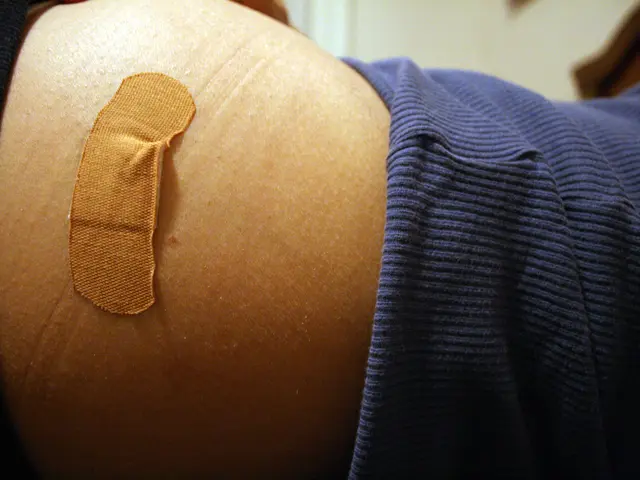Borax Acid Solution
Boric Acid, otherwise known as Boricum Acidum or Hydrogen Borate, is a multifaceted chemical compound that's not afraid to get its hands dirty. As an antiseptic disinfectant, it's a force to be reckoned with, stopping the pranks of fermentation and putrefaction in their tracks.
You may have stumbled upon it in various medical applications, from treating some unwelcome urinary tract issues to certain tenacious skin conditions. But let's dive deeper, shall we?
Masking its Ensnarling Embrace
- Chemical Formula: H3BO3
- Common Name: Boric Acid
- Other Names: Boracic Acid, Hydrogen Borate
The Anatomy of Boric Acid
Boric acid is a weak, monobasic Lewis acid, boasting antiseptic, antifungal, and mild astringent properties. It's a buff dude, occurring naturally in certain minerals, and it's no stranger to versatile usage – from antiseptics and insecticides to flame retardants and glass production.
The Intertwined Tales of Boric Acid
Boric acid's history is as old as dirt itself, dating back to the days of yore, when the Greeks and Romans honored its cleansing and healing prowess by using borax (a salt of boric acid). In the 19th century, it became the party-goer at any household remedy fiesta!
Homeopathic Homecoming
In homeopathy, Boricum Acidum, prepared through potentization (a process involving serial dilution and vigorous shaking), is believed to channel the energetic essence of the original substance, while shunning physical molecules.
The Homeopathic Highlights
- Eye infections, conjunctivitis, and styes with acrid, burning, and profuse discharge.
- Ear infections, otitis externa, and eczema around the ears.
- Vaginal discharge with itching, burning, and inflammation, especially in cases of yeast infections (candidiasis).
- Skin conditions, including eczema, dermatitis, and fungal infections, with symptoms of burning, itching, and redness.
- Urinary tract infections (UTIs) with burning pain during urination and frequent, scanty urine.
Safety Dance
When Boricum Acidum is used in homeopathic dilutions as prescribed, it's generally safe for more individuals than a Kardashian endorsement, including infants, pregnant women, and the elderly. Still, always bow to the guidance of a qualified homeopathic practitioner.
Government Regulation: Boric Acid, the Over-the-Counter Rebel
Homeopathic remedies, including Boricum Acidum, are often handled like over-the-counter drugs in many countries, such as the United States and Europe. These remedies are available in various potencies and formulations, including liquid dilutions and lactose pellets.
Boric Acid's Drug Pedigree
Boric Acid targets the urinary system and skin, demonstrating its effects through its antiseptic and astringent properties. It relieves ureteral pain, addresses frequent urination with burning and tenesmus, and exhibits consequences on the skin, including multiform erythema, oedema, and exfoliating dermatitis.
Indelible Marks: Key Characteristics of Boric Acid
- Antiseptic and disinfectant properties.
- Relieves pain in the region of the ureters.
- Addresses symptoms of frequent urination with burning and tenesmus.
- Exhibits effects on the skin, including multiform erythema, oedema, and exfoliating dermatitis.
- Influences the female reproductive system, relieving climacteric flushings and addressing vaginal coldness.
Exploring Organs: A Tour with Boric Acid
- Skin: Multiform erythema on the trunk and upper extremities, oedema around the eyes, exfoliating dermatitis.
- Female: Climacteric flushings, sensation of coldness in the vagina, frequent urination with burning and tenesmus.
Boric Acid: Allied Forces and Conflicting Opponents
- Symptoms worsen from coldness.
- Relief from antiseptic and disinfectant properties.
- Symptoms may be aggravated by heat or pressure.
Modalities: The powers that be
Boric Acid vs. Other Drugs: Friend or Foe?
Boric Acid may collaborate with other antiseptic agents in combination therapy. However, it might interact with certain medications or substances; exercise caution when using concurrently.
Beyond Homeopathy: The Roles of Boric Acid
These non-homeopathic uses of Boric Acid or related compounds can be quite potent in treating various conditions:
- Chronic Cystitis: Used as an injection or ingestion in a glass of hot milk.
- Boro-Glyceride (Boroglycerin): Used as a powerful antiseptic, topically on ulcerated surfaces, and in treating styes when diluted.
These applications illuminate the adaptability of these substances in addressing a myriad of medical conditions, from irritable urinary tract infections like cystitis to stubborn styes and ulcerated wounds. However, remember to use them under appropriate medical guidance and in the correct concentrations for safety and efficacy.
Prescription for Success: The Appropriate Dosage
Boric Acid dosage is usually determined by a healthcare professional.
Unanswered Questions: FAQs
1. What is Boric Acid used for?Boric Acid is an antiseptic disinfectant employed in various medical applications, particularly treating urinary tract issues and certain skin conditions.
2. Is Boric Acid safe to use?When used appropriately, Boric Acid is considered safe for its intended purposes. However, excessive or improper usage may lead to unwanted consequences, so tread carefully.
3. Can Boric Acid be used for skin conditions?Some skin conditions like erythema, oedema, and dermatitis can benefit from Boric Acid when used topically and under medical guidance.
4. Is Boric Acid suitable for vaginal use?In some cases, Boric Acid may be used intravaginally to treat specific conditions. However, consult a healthcare professional before trying this treatment.
Sneaking the Facts: Understanding Difficult Words
- Antiseptic: A substance that inhibits microbial growth and prevents infections.
- Putrefaction: The decomposition or decay of organic matter.
- Ureter: A duct carrying urine from the kidney to the bladder.
- Climacteric: The period leading to menopause characterized by hormonal changes.
- Tenesmus: Painful and unproductive straining to empty the bowel or bladder.
- Erythema: Redness of the skin due to inflammation or irritation.
- Exfoliating: Shedding or peeling thin layers, typically of skin.
This comprehensive drug profile offers deep insight into the myriad uses, effects, and precautions associated with Boric Acid.
- In the realm of health-and-wellness, Boric Acid can be found in skincare routines due to its antiseptic properties, helping to combat various skin conditions like erythema and dermatitis.
- Women's health benefits from Boric Acid as well, as it is used to treat certain vaginal issues, such as yeast infections and inflammation.
- Beyond skincare and women's health, Boric Acid plays a crucial role in the healthcare industry, serving as a disinfectant and antiseptic in medicine and science.








